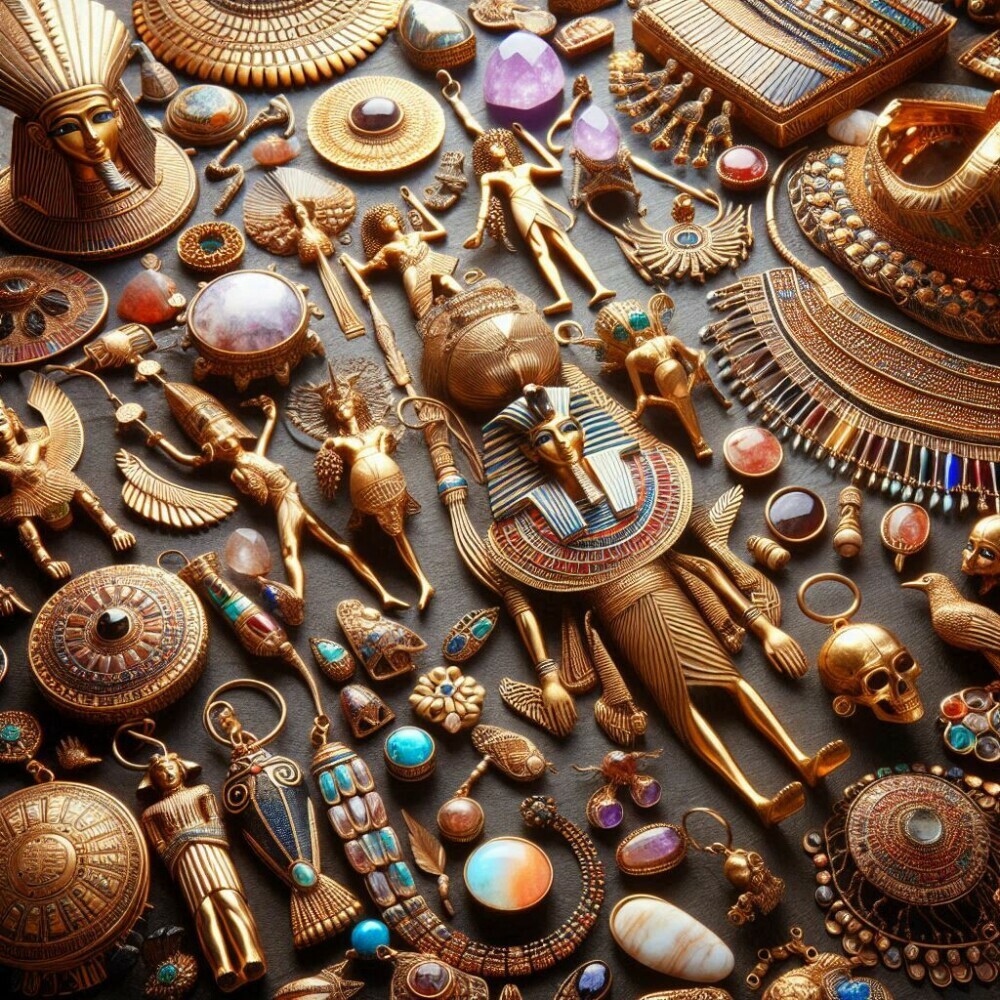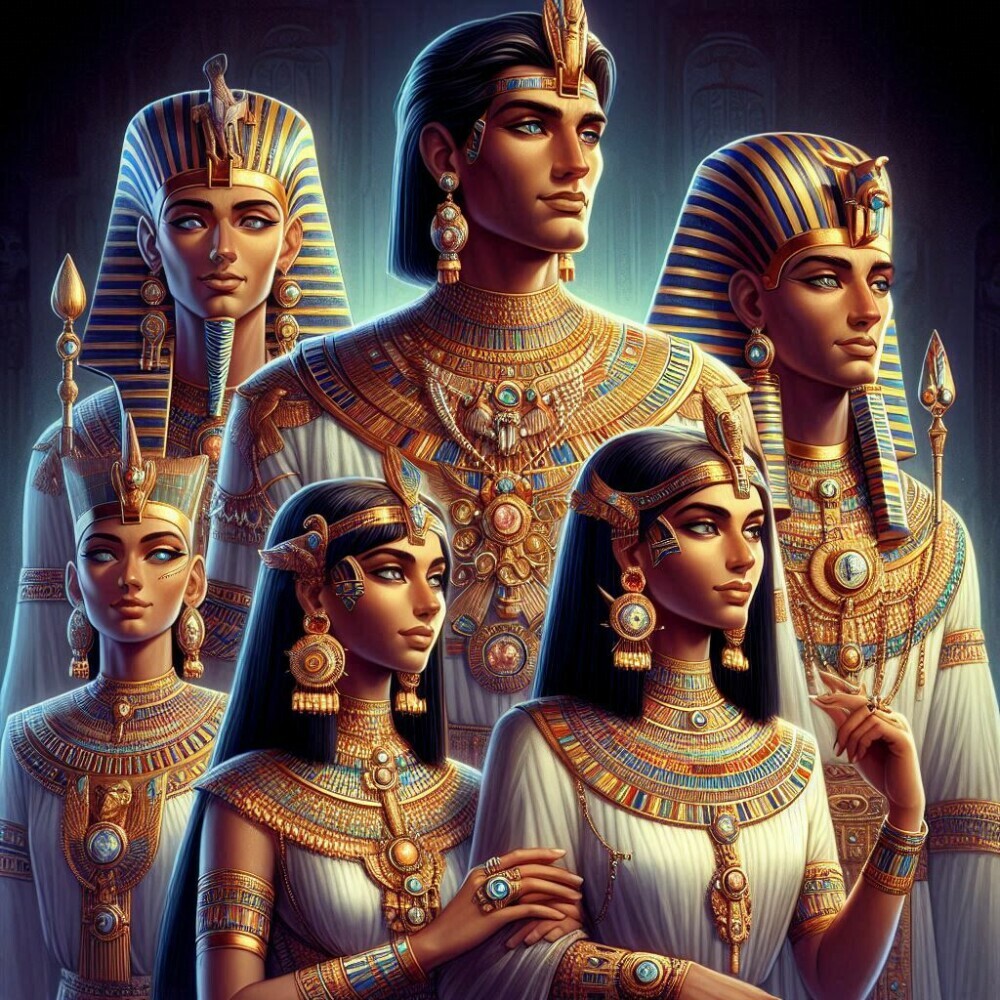 Ancient Egyptian jewelry
Ancient Egyptian jewelry
I often marvel at the historical significance of ancient Egyptian jewelry, not merely for its beauty but also for the profound narratives it holds within each crafted piece. In ancient Egypt, jewelry wasn’t simply a form of adornment. It transcended mere ornamentation to embody a multifaceted significance in the lives of the people. These artifacts were a visual language of symbolism that communicated status, power, and protection.
From commoners to pharaohs, jewelry signified more than wealth; it was an integral part of the social and spiritual fabric. A gold necklace could denote a person’s societal rank, while an amulet in the shape of the ‘Eye of Horus’ might offer protective assurances for both the present life and the afterlife. The idea that jewelry could accompany one’s soul into eternity illustrates its deep-rooted importance.
The intricate designs weren’t arbitrary—they expressed religious devotion, beliefs, and personal identification. Understanding these artifacts gives us extraordinary insight into the civilization’s values and how its people viewed their place in the cosmos. As we examine these precious objects, we don’t just see materials and craftsmanship; we witness the embodiment of an ancient worldview.
Jewelry also served as a medium for Egyptians to express their understanding of life and death. This can particularly be observed in the way jewelry was intertwined with mummification and burial customs, serving as amulets that offered supernatural protection and helped guide the dead through the afterlife.
In exploring these treasured artifacts further, we can uncover the rich tapestry of materials that ancient Egyptians employed to create their masterpieces—a direct reflection of the ingenuity and resourcefulness that characterized this illustrious culture. Thus, this leads us to the next part of our exploration: the diverse and bountiful materials that made up the building blocks of ancient Egyptian jewelry art.
From Earth’s Bounty to Sacred Adornments: Materials of Eternal Beauty
 Production of jewels in Ancient Egypt
Production of jewels in Ancient Egypt
When I think about ancient Egyptian jewelry, I’m struck by the astonishing array of materials that were transformed into artifacts of breathtaking beauty. These materials were more than just the means to create; they carried deep meanings and symbolized a variety of societal and spiritual ideals. The primary materials – gold, silver, and copper – were not chosen solely for their aesthetic appeal. Gold, resplendent and incorruptible, was associated with the sun god Ra and symbolized eternal life. It was the metal of the gods, treasured for its immunity to tarnish, reflecting the Egyptian quest for immortality.
Silver, though less common than gold, represented the moon and held its own sacred connotations. Its rarity made it a prized material for jewelry destined for high-status individuals. Copper, more abundant and easier to work with, made its way into the daily adornments of the common people, though it was no less significant in its luster and appeal.
Beyond metals, the ancient Egyptians revered a spectrum of colorful semi-precious stones each bearing their own hidden language. Turquoise, sourced from the Sinai Peninsula, served as a talisman for good fortune. Lapis lazuli, with its celestial blue shade, symbolized the heavens and was often sought after for its connection to the divine. Carnelian, represented the blood of Isis and was believed to have protective properties, while amethyst evoked calm and healing.
Not to forget faience, the magical material crafted from a mix of crushed quartz, lime, and alkali which was glazed to produce vibrant colors, most commonly a brilliant turquoise blue. This material was widely used due to its accessibility and resemblance to precious gemstones, offering a more economical yet symbolically rich alternative for jewelry.
This wonderful diversity in material selection was not about opulence alone but an intricate language through which Egyptians communicated their culture, beliefs, and desires. The materials used were a conscious choice to reflect the wearer’s identity, societal position, and spiritual affiliations .
Decoding Divine Design: The Symbolism and Themes in Jewelry Art
 Eye of Horus
Eye of Horus
As I explore the intricate world of ancient Egyptian jewelry, the rich tapestry of symbols and themes woven into each piece captures my attention. Think of it much like a language, where every symbol represents a word rich with meaning, designed not just to please the eye, but to communicate powerful concepts and beliefs.
The ankh, characterized by a loop atop a T-shape, is one of these potent symbols, representing life. It’s often seen clutched in the hands of deities or pharaohs as a symbol of their influence over the giving of life or even eternal life. You’ll notice the ankh making frequent appearances in tomb paintings and inscriptions, too, highlighting its deep-seated cultural importance.
Then there’s the scarab beetle, found in abundance among the jewelry pieces. This creature, sacred to the sun god Ra, embodied the ideas of rebirth and regeneration. Wearing a scarab amulet was akin to having a personal emblem of steadfast protection and hope for renewal.
The Eye of Horus, a symbol that may have caught your eye with its characteristic eye makeup, stands for protection and good health. Also known as ‘wedjat’, it’s thought to ward off evil, and assure the wearer of safety and well-being.
Lotus flowers, frequently depicted in headdresses and necklaces, signify rebirth and purity. They bloom with the dawn and close at dusk, paralleling the sun’s journey and, by extension, the rebirth of the soul in the afterlife.
These pieces also illustrate stories of gods and goddesses, acting as living portals to divine protection and benevolence. A necklace engraved with Hathor, the goddess of love and beauty, for example, might lend the wearer her grace and favor.
These symbols aren’t random; they’re deliberate expressions of ancient Egyptian culture and religion. Now, with a grasp on the rich symbolism, let’s take a closer look at the objects themselves in ‘The Spectrum of Egyptian Elegance: Diverse Jewelry Types’. Here, I’ll discuss how each form factor of jewelry, steeped in allegorical significance, found its place in the lives of the ancients.
The Spectrum of Egyptian Elegance: Diverse Jewelry Types
 From rings to statues – Ancient Egyptian jewelry artifacts
From rings to statues – Ancient Egyptian jewelry artifacts
Ancient Egyptians didn’t limit themselves to a handful of jewelry styles; their creativity knew no bounds. From the grand necklaces that graced the necks of the elite to the simple rings that adorned the fingers of the common people, there was a wide and varied spectrum of jewelry. Each piece wasn’t just a statement of fashion; it held specific meanings and intentions.
Necklaces, often made with beads of gold and colorful gemstones, were common. They ranged from broad collars, which covered the chest, to tight chokers worn close to the throat. Bracelets and anklets, sometimes indistinguishable from one another, were also prevalent. These often featured similar materials and designs to necklaces, establishing a harmonious aesthetic.
Rings weren’t mere ornaments; they often bore seals and served as personal signatures, essential in administrative documents. Earrings, though less common than other forms, were beloved by those who wore them, featuring intricate designs that could be quite elaborate.
Pendants and amulets, imbued with religious significance, were worn as both everyday and ceremonial pieces. They served as protections against evil and were integral to ensuring the wearer’s safety and well-being.
Headdresses weren’t solely for rulers or religious figures. They conveyed status and devotion and were often festooned with gold discs and gemstones, aimed at capturing the benevolence of the gods above.
Intricate and meaningful, every piece of ancient Egyptian jewelry was meticulously crafted with purpose and symbolism, providing us with insights into the complexity of their society and beliefs. As we wrap our understanding around these diverse types of jewelry, we’re led to one of the most enthralling chapters in the tale of ancient Egyptian opulence—the jewelry of the pharaohs and the royal family.
Regalia of the Divine Rulers: Royal Egyptian Jewelry
 Pharaons jewelry
Pharaons jewelry
I’m fascinated by how the luxurious jewelry pieces of ancient Egyptian pharaohs and their royal families encapsulate their wealth and power. These striking adornments went beyond mere ornamentation; they were emblematic of divine authority and majesty. It’s evident that the use of precious stones and elaborate designs was common, but there was more to it.
In studying royal jewelry, I find that each piece tells a story of the ruler’s life, achievements, or religious beliefs. Consider the intricate pectorals, wide collars, and ornate headdresses; their sheer complexity speaks volumes of their significance. These items were not merely worn for aesthetic appeal but were also integral to royal ceremonies.
The craftsmanship in royal jewelry, from the delicate use of gold to the setting of precious gems like emeralds or pearls, displays the artisans’ unmatched skill. Such splendors were exclusive to royalty, underscoring the divide between the common citizens and the god-like stature of the pharaohs.
In the broader context, royal jewelry did more than dazzle spectators; it acted as a tool for propaganda and storytelling. Symbols like the falcon, representing Horus, or the cobra, associated with Wadjet, were integrated into designs, conveying messages of protection, strength, and the royal’s link to the divine.
Remarkably, much of what we know about these magnificent pieces comes from their discovery in royal tombs. This transition into discussing funerary jewelry is natural, as it underscores the Egyptians’ preparation for the afterlife. Indeed, royal jewelry didn’t simply mark social status in the temporal world but also played a pivotal role in the pharaohs’ journey to eternity.
Jewels for the Journey: The Sacred Role of Funerary Jewelry
 Death mask of Tutankhamun
Death mask of Tutankhamun
I find the practices surrounding funerary jewelry in ancient Egypt deeply fascinating. For the Egyptians, death was not the end, but a passage to an eternal life. Consequently, the jewelry buried with the deceased wasn’t a mere collection of trinkets; it served as essential gear for the soul’s voyage into the beyond.
Imagine stumbling upon a tomb, untouched for millennia, only to find it sparkling with jewels that narrate tales of a life once lived and a journey anticipated. These meticulously crafted amulets, necklaces, and bracelets were laden with symbols designed to guide and protect. Gold, believed to be the flesh of the gods, affirmed the deity-like status of the departed in the afterlife.
Significant pieces have emerged from ancient sands to astound us, like Tutankhamun’s burial treasures, rich with lapis lazuli and gold, serving as not only artifacts of majesty but also as celestial maps and sacred texts in material form.
The practice of adorning the deceased with these precious items was grounded in an unwavering belief in an afterlife that required material wealth for a soul’s sustenance and protection. This ancient practice provides a mirror into their convictions, their hopes, and the high craftsmanship that was bestowed upon items meant to last an eternity.
As I move into discussing the craftsmanship, it’s important to remember how the quality and complexity of the jewelry unearthed from these resting places speak volumes about the incredible skills and artistic vision of the jewelers of yesteryear. These artisans shaped a legacy that endures in every thread of gold and every carved gemstone.
The Legacy and Timeless Influence of Ancient Egyptian Jewelry
The intricate art of ancient Egyptian jewelry leaves an indelible mark on both history and modern design, transcending time and culture. These treasures are much more than mere remnants of a bygone era; they’re a testament to the craft and vision of artisans whose work has inspired countless generations.
The techniques the Egyptian jewelers mastered, such as granulation, filigree, and cloisonné, require an extraordinary level of skill and patience. These methods have stood the test of time, often serving as a benchmark for fine craftsmanship in today’s jewelry making.
Museums across the globe showcase these stunning artifacts, allowing the public to witness firsthand the beauty and intricacy of each piece. This continued preservation and display not only honor the original creators but also ensure that the art form continues to influence and teach.
Modern jewelers still look to ancient Egyptian jewelry for inspiration, with its timeless motifs and symbolism finding new life in contemporary designs. By incorporating elements of Egyptian artistry, designers tap into a rich visual language that resonates as much today as it did thousands of years ago.
As wearable art and as historical artifacts, the legacy of ancient Egyptian jewelry artifacts remains dynamic and alive. It reminds us that beauty and meaning crafted with intention can endure well beyond the lifetimes of their creators, occupying a cherished place in both history and in the hearts of those who appreciate their significance.

